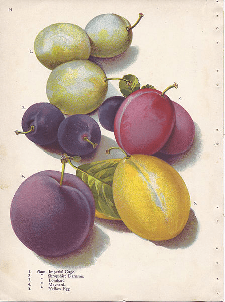Plum vs Prune
Drying has been a preservation method used since ancient times to prevent food waste, particularly for easily perishable items like fruits. By removing moisture from the food, it lasts longer. However, some dried fruits can be difficult to differentiate from their fresh counterparts, leading to confusion among consumers. A prime example of this is the ongoing confusion between prunes and plums.
What is a prune?
A prune can refer to any variety of plum cultivars, usually Prunus domestica or the European Plum, mostly sold as a dried fruit. Over 1000 cultivars of plum are grown for drying, with some popular varieties including the improved French prune, Tulare Giant, Sutter, Imperial, Moyer, Greengage, and Italian prune. Prunes are consumed cooked in both sweet and savory dishes or eaten by themselves. They are a popular ingredient in North African tagines, stewed prune compote, traditional Jewish dishes like Tzimmes, Nordic prune kisel typically served with rice pudding, traditional Norwegian dessert fruit soup, and holiday dishes such as stuffing or cake. Prune Danish pastries are popular on the U.S East Coast, and prune juice is a popular beverage worldwide. Prunes also have high sugar content, which is fermented to form a cider-like drink called jerkum in the Cotswolds.
Prunes are known for their high content of dietary fiber and mild laxatives, including phenolic compounds. They are used as home remedies for constipation and are high in antioxidants, making them a popular healthy snack.
What is a plum?
A plum is a drupe fruit that grows on the plant belonging to the subgenus Prunus of the genus Prunus. The mature plum fruit has a dusty white coating, an epicuticular wax coating known as “wax bloom.” Plums are relatives of the nectarine, peach, and almond, featuring a hard stone pit surrounding their seeds. Plum trees blossom in different months in different parts of the year. In Taiwan, plum trees blossom in January, whereas in the United States, they blossom in April.
There are 19 to 40 species of plum, but only the European plum and the Japanese plum have worldwide commercial significance. Plums can range in taste from sweet to tart and can be eaten fresh or used in jams and other recipes. Plum juice is also fermented and made into plum wine. China is currently the world’s largest producer of plums.
Plums are high in calories and a good source of dietary fiber, but much of their caloric content comes from sugars. They also have high levels of Vitamin A, C, and K.
What is the difference between Plum and Prune?
The difference between a prune and a plum, while rather evident, may be confusing for many to discern. Here are a few reasons why the two ingredients differ from one another:
– A plum is a drupe fruit that belongs to the subgenus Prunus. A prune can refer to any variety of plum cultivars.
– In general use, a plum is the fresh fruit. A prune is the dried plum. However, not all plum varieties can be dried to make prunes.
– Prune may also be a different fruit separate from the plum. For example, Italian prunes are grown as prunes and dried for packaging.
Key Takeaways
- Plums are fresh fruits, while prunes are dried plums or specific cultivars of plums.
- Both plums and prunes are high in dietary fiber, vitamins, and antioxidants, but prunes are particularly known for their mild laxative properties.
- Not all plum varieties can be dried to make prunes, and some prunes may be separate fruits from plums, like Italian prunes.
